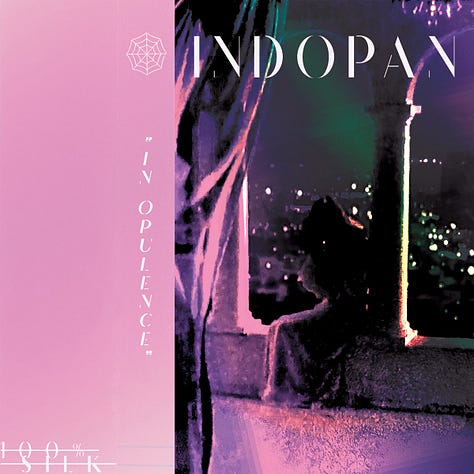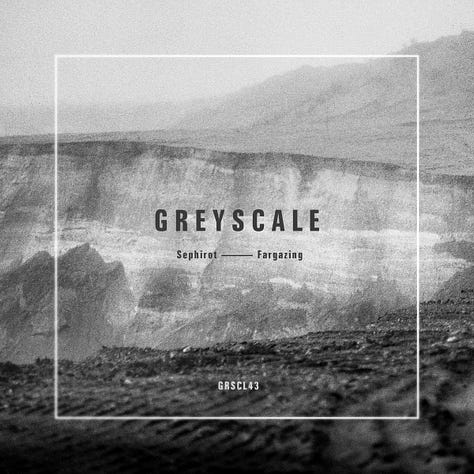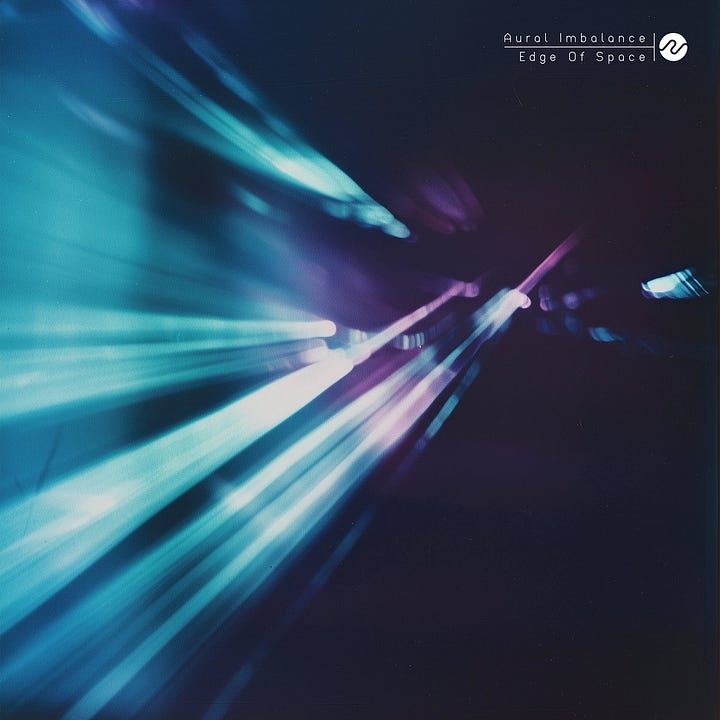My main goal in today’s post is to shine a little light on some of the electronic albums I’ve liked best so far this year. The secondary motive is to ask: What happens in a language where you know the syntax but not the vocabulary?
I don’t go to clubs. I’m not a dancer. I don’t really understand what DJs do. Hell, I don’t even really understand how electronic music production works beyond… software and machines. All this means that, although I listen to a lot of electronic music, I have internalized an imposter mentality. I can recognize how things come together, but I don’t know the words.
But on the other hand, who gives a shit, right? If you’re an omnivorous listener, you hear things that you like and things that you disdain. Each encounter with someone else’s music can also be a signpost on the way to the next journey, whether or not you already have a mental map of the terrain.
Then again, I have to admit that having spent a long time in the ‘writing about heavy metal’ trenches, I am not always particularly large-spirited when I see someone writing like a no-account doofus about the sounds that I know a little deeper in my bones. I’ll happily let you call me a hypocrite as much as you like, but maybe the key difference comes down to humility. I will try to grant them the grace I would hope for myself, which is to approach both listening and writing as an act of opening, not closure.
So! Here are some things I like. What about you?



Ica Rus - This Way Home
Ica Rus is an alias of German-born/Stockholm-residing Joel Mull, and on This Way Home he offers an hour of rich, deep, grooving techno that feels perfect for long, nighttime drives. The strings and field recordings on “Kottarna i Skogen” provide a pastoral element, while the stuttering snares and squelching, acid-leaning synth on “Atomic Spring” spin out a slightly higher intensity. Second-half highlight “Neon Attack,” however, is so rich and melancholic that it feels like it could be a latter-day Depeche Mode or New Order instrumental track. The nocturnal vibe on the album’s one vocal track (“Magnetisk Rytm”) is so strong that the tune feels like it would’ve landed perfectly on one of Deep Dish’s Global Underground sets. This is Good Music, is my point.
Giash - Lashajukka
Hungary’s Bertalan Baglyas produces under the name Giash, and Lashajukka offers five longform excursions into murky, minimalist deep house/techno. The atmosphere here is mysterious and a bit sinister, and at times there’s an interesting tension as if the lighter elements of a song are fighting to tear themselves loose from the growling low-end. On “Glasswork Wheel,” for example, there’s an undercurrent of melodic percussion that sounds a little bit like someone playing the marimba while also trying to drown it. Even when the tempo kicks up and things are superficially playful (as on “Jairo”), there’s often at least one layer of the song that feels like it might wander away. A dense and rewarding listen.
Sieren - Emergence
How’s this for churlishness? On my first dip into Sieren’s Emergence, my knee-jerk thought was, “Sure, it’s nice, but is it too pleasant?” What kind of jaded, shriveled husk of a curmudgeon listens to beautiful music and says, “Let’s have something like this, but that gives less pleasure”? Anyway, the music of Matthias Frick’s Sieren is pleasant as balls, and that ought to be enough. For me, these tunes land somewhere between trance and downtempo, with most feeling like they could slot into any set on London’s Anjunadeep label. There are big, driving basslines, heavenly synth pads, thoughtful breakbeats (see especially “Heights” and “Linked”) and an overall attitude of airy beneficence.



Indopan - In Opulence
In Opulence is Andrew Morrison’s second album as Indopan for Los Angeles’s 100% Silk, a label whose fetishization of neon, lo-fi, and cassette art screams “vaporwave” at me. However, I will readily admit to you that I do not know what vaporwave is. I am not proud of this, but like anyone still using the word “hipster” to mean “young white person doing something I dislike,” I will use “vaporwave” to mean “aggressively chintzy electronic music that I dislike.” This does not apply to Indopan! I am terribly sorry if I have taken you down a wholly unproductive rhetorical alleyway. In Opulence is, well, aggressively chintzy electronic music that I quite like. Give “Marshman” a whirl and let the sounds do the explaining that these words refuse to.
Fluxion - Haze
Konstantinos Soublis has been producing music as Fluxion since the late ‘90s, with his earliest material released on the Chain Reaction label founded by the production duo Basic Channel. This means, for anyone playing at home, that Fluxion’s dub techno bona fides are unimpeachable. Haze provides plenty of space for that classic ping and reverb, but it’s also notable for how diverse it is. “Magenta” is perhaps the most notable dubby highlight, with a pipe organ undercurrent that becomes more prominent and strikingly beautiful as the track unfolds. “Nexus has a bit of the strings and muted thud of Wolfgang Voigt’s Gas, while “Reflections” rewards close listening with its subtle backdrop of insect drone and flute.
Sephirot - Fargazing
Talk about something that goes deeeeeeeeeep into the aquatic paradise of ambient dub techno. Sephirot’s debut Fargazing is a pure sensory trip of thump and wash, tape hiss and blissed-out synth. “Midnight, Our” sounds like Aphex Twin’s Selected Ambient Works ‘85-’92 by way of Deepchord, while “Midsummer” has some tricky shuffling step percussion more akin to early Burial. For those days when you just need a head bath, Fargazing is the real deal.


Mattheis - Waiting for the Silhouette
Waiting for the Silhouette does one of those things I don’t really know how to describe, which is to make speedy, precise techno beats that pan back out into something almost serene. Tunes like “Sleet Falls” and “Windthrow” move quickly but feel subdued, with skittering drum rhythms that form a slipstream of sound. “All Meanders” removes any drums to hoist up a tower of fractured, twinkling synth arpeggios, but then a later song like “Col” sounds like a robot playing racquetball in the echoing hull of an oil tanker that has sprung a leak.
Yagya - Vor
Aðalsteinn Guðmundsson’s music as Yagya has also traveled the pristine corridors of dub techno, particularly on landmark early albums like Rigning and Rhythm of Snow. His last few albums haven’t particularly landed for me, but Vor is a hugely satisfying return to some of that earlier sound. The album is ostensibly split into a “Spring” half and a “Fall” half, but to me the atmosphere is remarkably consistent throughout: a strong thumping pulse and dub reverb, and such hazily warm synths that the endless 4/4 becomes like slow motion disco for cloud people.


Re:fraction - Xanadu Terrain
Hey, so what can I say? I really like dubbed-out techno ambience. Re:fraction is the nom de dub of Sweden’s Gustav Sandstedt, and his latest album Xanadu Terrain offers an hour of deep, reverberating dub techno with a diamond-tip precision. Compared with the Sephirot album above, Re:fraction’s productions are crisper and a touch heavier, with fat, rounded bass and particularly buoyant synth pads. The inspiration for the album is the landscape of one of the moons of Saturn, so if you close your eyes and drift with the insistent pulsations, you might hear them as solar radiation bouncing off the billions of shards of encircling ice.
Aural Imbalance - Edge of Space
Closing things out this week is the latest album from Simon Huxtable’s Aural Imbalance project, the serene and celestial drum and bass of Edge of Space. Like a chilled-out junglist’s flotation tank, Edge of Space works best if you approach it as eight different levels of sheer suspension. Sure, if you’re the type who wants to dance to d&b, that’s fair play, but even when the breakbeats whip up a busy racket (see “Neptune” and the full Amen-break workout “Warpcore”), the mood hews closer to something like LTJ Bukem’s eternal masterpiece Journey Inwards. Call it a fast sound for slowing down the mind.



